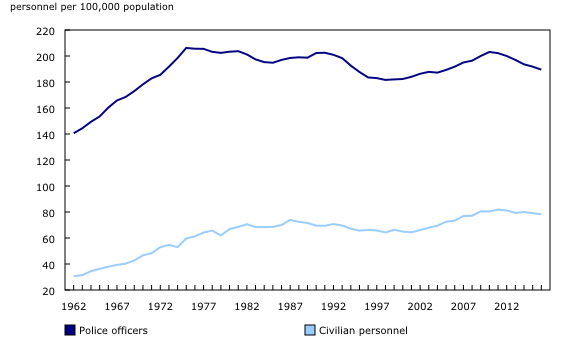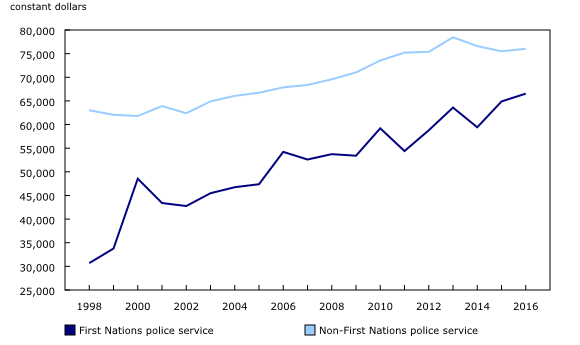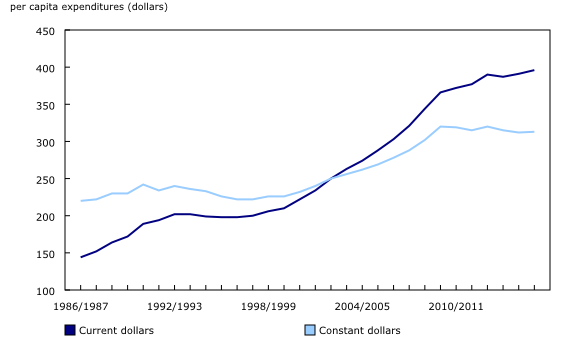Police resources in Canada, 2016
Archived Content
Information identified as archived is provided for reference, research or recordkeeping purposes. It is not subject to the Government of Canada Web Standards and has not been altered or updated since it was archived. Please "contact us" to request a format other than those available.
Released: 2017-03-29
The number of police officers (per 100,000 people) in Canada fell for a fifth consecutive year in 2016, reaching its lowest rate since 2005. In 2016, police officer strength stood at 190 officers per 100,000 population, down 1.2% from 2015 and lower than the peak strength of 206 officers in 1975.
Overall, there were 68,773 police officers working for police services in Canada as of May 2016, about the same number as in 2015.
These findings are included in the new Juristat article "Police resources in Canada, 2016" released today.
Police strength based on population served declines for fifth consecutive year
The rate of police strength fell in most jurisdictions in 2016. The exceptions were Newfoundland and Labrador (+2.1%) and Yukon (+5.9%). New Brunswick, Alberta and British Columbia reported relatively stable rates.
Across the country in 2016, there were 50 stand-alone municipal police services which served a population greater than 100,000. Of these services, 17 saw an increase in their rate of police strength, 24 saw a decrease in strength and 9 reported no notable change. The largest increases in police strength were in the British Columbia municipalities of Coquitlam (+15%) and Surrey (+13%), and in the Quebec municipality of Terrebonne (+9%).
Civilian personnel accounting for greater proportion of employees
Police services are increasingly made up of civilian members such as clerks, communications personnel, managers and professionals, security officers and school crossing guards. On May 15, 2016, police services employed 28,422 civilians. The proportion of civilians in policing has gradually increased since data were first collected, growing from 18% in 1962 to 29% in 2016.
Growth has been concentrated in the category of managers and professionals, which accounted for 10% of all police personnel in 2016, compared with less than 1% in 1986.
Proportion of female police officers continues to increase
The evolution of policing has also meant more women joining the ranks. In 2016, the 14,545 female officers in Canada accounted for 21% of all officers. In comparison, women constituted 4% of officers in 1986. The proportion of female sworn officers has increased every year since collection began in 1986.
Although women account for a smaller proportion of senior and non-commissioned officers compared with constables, their presence in the higher ranks continues to increase. In 2016, 13% of senior officers were women, compared with 6% in 2006 and less than 1% in 1986. Among non-commissioned officers or chiefs, 18% were women in 2016 compared with 11% in 2006 and less than 1% in 1986.
Growth in overall proportion of officers aged 45 years and older
With an aging population, the loss of experienced individuals to pending retirements remain a concern within the workforce. In policing, the proportion of officers aged 45 years and older has grown since 2012, when data were first collected. That year, officers aged 45 years and older accounted for 32% of all officers. In 2016, the proportion grew to 36%.
In the 2015 calendar year or the 2015/2016 fiscal year, 10% of all police officers in Canada were eligible to retire, but 3% or 1,822 officers actually did. Those who did retire accounted for 69% of all police officers who departed police services that year. The other 31% departed for reasons other than retirement, such as being hired by another police service or career change.

In celebration of the country's 150th birthday, Statistics Canada is presenting snapshots from our rich statistical history.
Policing is one of the longest standing institutions in this country, one that pre-dates Confederation by more than 30 years.
As populations expanded and settled across the country, policing in Canada has evolved and has seen the establishment of the Royal Canadian Mounted Police, numerous municipal services, some First Nations police services and three provincial police services.
According to some of the earliest information on occupations from the Census of Canada, there were 1,313 "policemen and detectives" in Canada in 1881. Just over 80 years later, according to Statistics Canada's first Police Administration Survey conducted in 1962, policing comprised just over 26,100 police officers and 5,700 civilian personnel that year. The number of police officers was 141 officers per 100,000 population, about 35% lower than the 2016 rate.
Salaries among First Nations police services personnel are consistently lower compared with other services, but the gap is narrowing
Overall, the average annual salary for police personnel in Canada in 2015/2016, including both officers and civilians, was $96,231. When controlling for inflation, this amount has generally grown since 1995/1996, including a 1% increase from 2014/2015 to 2015/2016.
Although the average salaries reported by First Nations services (when accounting for inflation) have been consistently lower than for other types of police services, the gap has narrowed in recent years. In 2015/2016, the average salary in constant 2002 dollars for personnel employed by First Nations police services was $66,536 compared with $76,024 for personnel of non-First Nations police services. Of note historically, First Nations police services have reported having a younger police service than all other types of services. Numerous factors could explain the difference in average salaries, for example, differences in age profile or tenure.
From 2006/2007 to 2015/2016, average salaries in constant dollars for personnel employed by First Nations police services grew by 26%, compared with 11% for non-First Nations police services.
Various factors can contribute to differences in average salaries among police services. These may include funding formulas, presence of specialized policing services, level of information technology requirements, complexity and size of administration functions, and age profile and tenure of employees. Also, average salary comparisons do not take into account differences in cost of living among the locations of the police services.
Operating expenditures for policing surpass $14 billion in 2015/2016
Year-end operating expenditures for police services in Canada in 2015/2016 totalled $14.2 billion in current dollars. These expenditures comprised salaries and wages (66%), benefits (15%) and other operating expenditures (19%).
Accounting for inflation, total operating expenditures rose by 1% from the previous year, with the largest increases in Saskatchewan (+5%), Ontario (+3%) and Alberta (+3%).
When adjusting for inflation, police spending increased annually by an average of 3.7% a year from 1997/1998 to 2010/2011, but has since remained relatively stable with increases in 2012/2013 and in 2015/2016.
When accounting for population and inflation, policing operational costs in 2015/2016 amounted to $313 per capita, almost unchanged from $312 per capita in 2014/2015.
Note to readers
Several factors may contribute to differences in the number of police officers (per 100,000 people) across jurisdictions and police services. These include differences in police services' priorities, policies, procedures and enforcement practices, and the availability of resources.
In Canada, information on police personnel and expenditures is collected by Statistics Canada through the annual Police Administration Survey. Using data reported by each police service in Canada, this report provides details on police personnel at the national, provincial and territorial, and respondent levels.
Data in this report represent two distinct time periods. Most of the information on police personnel is based on a "snapshot date" of May 15, 2016, while data on hirings, departures, retirements, eligibility to retire, and expenditures represent the calendar year ending December 31, 2015 (or March 31, 2016, for those police services operating on a fiscal year).
In this release, rates with a percent change that rounds to 0% are considered stable.
Products
The Juristat article "Police resources in Canada, 2016" (85-002-X) is now available.
Contact information
For more information, or to enquire about the concepts, methods or data quality of this release, contact us (toll-free 1-800-263-1136; 514-283-8300; STATCAN.infostats-infostats.STATCAN@canada.ca) or Media Relations (613-951-4636; STATCAN.mediahotline-ligneinfomedias.STATCAN@canada.ca).
- Date modified:




